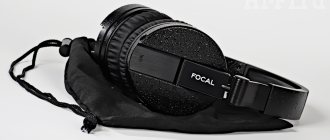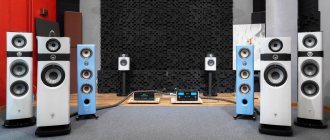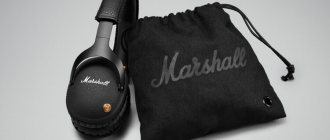INTRODUCTION
It’s like a staircase to heaven, only in reverse - I descended from heaven to earth in my acquaintance with Focal products.
Starting with the mind-blowing tops represented by Stellia and Utopia, I continued with the elegant and beautiful-sounding Clear, and I will finish, as you may have already guessed, with Focal Elegia. And at the same time, I will form an opinion about this model, not without regard to its position in the hierarchy of Focal models. After listening to 3 models, I was convinced of Focal’s commitment to a certain sound character: as smooth, airy and transparent as possible, without tinting and carefully capturing the smallest details, creating a hyper-realistic picture of the musical canvas. Is Elegia capable of performing this technically complex program? Let's figure it out.
PACKAGING, DESIGN, ERGONOMICS
Elegia comes in a matte black box made of thick cardboard, similar to Clear, only slightly thinner. This is due to the difference in configuration; Elegia received only one cable, 1.2 meters with a combined 3.5/6.3 mm jack. I'm glad that the cable itself is the same as that of the older model. Another thing is that it has questionable ergonomics due to its rigidity; I can hardly imagine using headphones outside the home with such an “iron” insulator.
As well as the transport case: the same color as Clear (dark gray) and the same design as Stellia. In general, Focal didn’t bother with the design of the entire model line, they decided to do it once, but well, very well, Elegia has the same exact shape as the rest of Focal’s headphones. The differences in the models lie in small details, mainly dictated by the acoustic performance and status - for example, the closed Stellia has a perforated frame of the cups, covered with premium quality genuine leather, while the Elegia has a plastic lid on the cups, stylized to match the perforations in the Stellia.
Continuing with the earcup theme, the Focal logo is designed in a very fine mesh design, creating a compensation port to help alleviate some of the low-frequency overload issues with closed-back headphones. The solution is effective and French elegant.
While the headband is completely identical to Clear, the ear pads are not. Because The headphones have a closed-type design; the ear pads are made of microfiber without perforation. Therefore, as expected, the headphones should be “warmer” than the same Clear ones, but I didn’t experience any problems with this. Also, there is no fabric insert inside the ear pads themselves, as was the case on other Focal models that I visited. Otherwise, even blindly, by touch, you can recognize the products of the French, if necessary.
Like the Clear, the Elegia uses a proprietary 40mm M-dome dynamic driver technology made from aluminum-magnesium alloy with ultra-lightweight surrounds and a frameless copper coil. The principle is the same - the material varies.
By the way, about numbers: in comparison with Clear, Elegia's sensitivity has increased slightly and its resistance has decreased (106 dB and 35 Ohms). The headphones sounded fully, while maintaining the dynamics and depth of the low frequencies, from the 300-milliwatt Lotoo paw 6000. With the luxurious FluxLab Iriy tube, the volume increased noticeably, and the sound became a little more tangible, the amplifier added physicality to the sound and improved the transmission of sound textures. With a good source we have a velvety, rough sound, with a portable one we have a smoother and lighter sound.
Focal Elegia headphones
When Focal began releasing one audiophile headphone model after another, probably some music lover, having tried the sound of open Elear, Clear or Utopia, immediately sighed dreamily - if only there were exactly these, only closed ones, he would definitely take them. Well, now there is no need to dream about them - they exist.
Before I open the box of the newest Elegies, I want to convey three important messages for anyone interested in personal audio in general and the Focal brand in particular. First: these models use the same engineering and technological base as other Focal headphones in the audiophile series, which have collected a lot of awards over the past two or three years. Second: the parameters of branded drivers with M-domes have been significantly changed in comparison with open analogues - the resistance has been reduced from 80 to 35 Ohms with a slightly increased sensitivity (105 dB) opens up excellent opportunities for using headphones with any standard-power mobile audio devices. And the third (and, I think, the most pleasant) message is that the manufacturer kept its promise to keep within the price category of up to 1000 euros and even exceeded it a little in your favor - the recommended price of Elegia turned out to be even lower than that of Elear - its closest open classmates . Well, now let's open the package.
The design of the headband is as reliable and comfortable as that of other Focal representatives of the audiophile series, and the ear cushions differ only in the design of the covering.
The new items are well made. The design of the headband is as reliable and comfortable as that of other Focal representatives of the audiophile series, and the cushions of the ear pads differ only in the design of the covering - in the “Elegies” it is made of microfiber in two colors with a light compacted inner insert, which gives the product a rather fashionable and memorable look. If you look closely, you will notice another difference - inside the cases there is no characteristic “transparent” perimeter of the driver basket, and the ovals themselves, which carry sealed covers with a metal insert, do not look as bulky as those of open models. By the way, the weight is also less – 20 grams compared to Elear.
But despite their relative compactness, these new products should without a doubt be classified as true surround-type headphones without any “overhead” compromises - in this regard, they are more advanced than the entire Listen series. The size, shape, strength and uniformity of pressure of the soft rollers to the head are selected in such a way that good sound insulation and the necessary comfort for long hours of listening are achieved, which will be highly appreciated by anyone who often has to fly long distances by plane (if I have such a business trip, I I can tell you exactly how long you can sit with “Elegies” on your head). There is only a small problem - the headphones do not come with airplane adapters. In general, the contents of the box are minimalist: the buyer receives only a transport case, a 1.2-meter cable with a 3.5 mm jack and a quarter-inch adapter. The wire has a normal Y-configuration, is removable and equipped with standard connectors - replacing it with another, including a balanced one, will not be a problem. The ear pads can also be easily removed.
They are unique in that the emitter, printed from a thin sheet of lightweight aluminum-magnesium alloy and suspended on a very elastic suspension only 110 microns thick, has a complex profile.
The main feature of “Elegies” is, without a doubt, the heads. They are unique in that the driver, printed from a thin sheet of lightweight aluminum-magnesium alloy and suspended on a very elastic suspension with a thickness of only 110 microns, has a complex profile and, in cross-section, resembles an inverted letter M. This shape not only gives the 40 mm cone additional rigidity, but it also forms a thin inner edge on which the voice coil is wound. Due to this, a minimum moving mass is achieved.
In open models, M-drivers also featured a tubeless magnetic drive design. Elegia also inherited a similar solution in general terms, but in this case it is no longer possible to consider the heads “tubeless” due to the closed design of the headphones themselves; moreover, the cavity on the other side of the radiating membrane is supplemented with a large, ingenious insert with different-sized honeycombs to suppress resonances.
It's less like a reproduction with a perfect scene and precise sound, and more like a live performance with very expressive articulation.
The phrase “first closed”, which the company uses in the presentation of “Elegies,” may scare some, but it should not be taken literally. This only applies to the audiophile series. In general, Focal's experience in developing closed-back headphones is very enviable, not only in the household, but also in the professional studio field. I would be very surprised if the new models contained at least some acoustic shortcomings or compromises characteristic of the “raw” models. So they are not there. According to the first impression, even unheated “Elegies” sound with luxurious, full-fledged dynamics without range compression typical of other closed models. According to the passport data, the distortions they introduce are completely negligible - even less than those of open structures. But the main thing is that they have neither a pronounced “shell” tint, nor sharp local distortions in the frequency response caused by internal resonances. The frequency range is really huge and Focal-like linear - I heard only two weakly expressed smooth rises (approximately 400 - 500 and 1200 - 1400 Hz), which will most likely smooth out after the drivers have fully “warmed up”.
Now let's move on to specifics. From the standard laptop output, the sound is rustic and a little rough - I immediately recognized in them all the “jambs” of the not very powerful amplifier built into the Macbook Air (it often “pleases” with insufficiently intelligible bass, dirty mids and tinted highs). Nevertheless, “Elegies” in such a connection showed a fairly high volume reserve and good detail.
They are also compatible with smartphones according to all criteria, but what surprised me most was their sensitivity to changing devices. With one model, which, as I always thought, had a fairly powerful output, Elegia sounded surprisingly lyrical and soft, and with another model, which could barely handle even sensitive plug-in monitors, the sound sharply increased in dynamics and richness of timbres. The third combination gave a balance between strength and harmony. True, in no case was it possible to talk about fine detailing. The standard class of amplifiers “Focals” of the audiophile series are shown immediately, without hiding anything. And this should be taken into account when choosing a decent source for headphones, although you definitely shouldn’t make conclusions about the capabilities of “Elegies” based on listening from smartphones - you will hear what their chipsets are capable of, not headphones.
The most stringent test for purity and truthfulness - playing well-recorded piano compositions - “Elegies” pass with flying colors, showing stunning realism, “air” and “velvet”.
Switching to the Denon DA-10 portable amplifier/DAC results in much more interesting results. A slightly highlighted “warmed up” midrange remains and conceals the bass, making it seem a little dry and restrained, but overall the sound is much richer and much more airy. It seems to be concentrated - there are many details and tonal shades, both dynamic dominants and subtle reverberations are expressed. It's less like a reproduction with a perfect scene and precise sound, and more like a live performance with very expressive articulation. Against the background of such a dense musical pattern, it may seem as if the upper ringing part of the range is not conveyed sharply and expressively enough, but for now let’s wait with conclusions. I can say for sure that for “Elegies” a normal output level setting is preferable. Switching to High Gain is undesirable - we lose transparency and structure, and the volume jumps to levels that are simply dangerous for hearing. But even in the latter case, I did not notice any distortion or dirt. The overload capacity of the headphones is very high.
From an integrated amplifier with a separate telephone stage (and even with a built-in patented crossfade), we get the most balanced and engaging sound. The stage space seems more compact, but it is truly a space with three-dimensional features, and not imaginary sources collected in the head on one axis - distant plans are readable, localization is better, each instrument has a body. The middle is still somewhat prominent, but the bass region is filled amazingly - there is strength, speed, and a complex colorful texture in the after-sounds. You don’t have to worry about accents and tints in the main strip - they are expressed to such an insignificant degree that you immediately forget about them. The most stringent test for purity and truthfulness - playing well-recorded piano compositions - “Elegies” pass with flying colors, showing stunning realism, “air” and “velvet”. But although the entire sound leaves the impression of being solid, there is one small “but” that concerns only the upper band. In this register, the new headphones are still not as sophisticated and neutral as the older open-back Clear or Utopia models. They reflect the straightforward nature of the more affordable Elear.
This is not a claim, but simply a statement of fact. I don’t know whether we should expect Focal to release even more expensive closed models with advanced beryllium drivers, but the level of “Elegies” is already high enough to give yourself the opportunity to listen to music with exemplary quality not only at home.
Focal Elegia
Manufacturer: Vervent Audio Group (France)
www.focal.com/ru
Resistance: 35 Ohm || Acoustic design: closed || Playback range: 5 - 23,000 Hz || Sensitivity: 105dB/1mW || Distortion: less than 0.1% || Weight: 430 g || Price per pair: 74,900 rub.
SYSTEM
- Sources
- smartphones Apple iPhone 8S, Nokia Lumia 930, Redmi 6A
- laptop Apple MacBook Air A1465
- Amplifier/DAC Denon DA-10
- Integrated amplifier McIntosh MA7200
- Cables
- USB InAkustik Referenz High Speed USB 2.0
- power InAkustik Referenz AC-1502 and Referenz Power Bar AC-1502-P6
share
Tags: FocalFocal ElegiaGood buy
SOUND
In general, these are Focal's flesh-and-blood headphones with smooth sound, filling the imaginary scene with after-sounds and tending to emphasize micro-contrasts. From closed headphones you expect more massive bass and a slightly more intimate construction of space, but no, Elegia retains the Focal sound signature, while doing an excellent job of soundproofing. You can listen to them quietly even in a noisy room.
The headphones build a good stage : it is not as large as on open Focals, but it has the three-dimensionality and holographic sound inherent in more expensive models, where each sound is perfectly localized, and this effect is truly three-dimensional, few headphones use space so effectively, working through an imaginary scene “up.” Perhaps, such an indicative work with Focal space is a consequence of the peculiarity of installing the emitter in the bowls - they are traditionally installed not strictly “in the ear”, but at a slight angle. The middle is vocal-centric, the remaining sounds seem to envelop the vocalist, creating a semblance of circles on the water. Despite the closed form factor, Elegia does not sound constrained.
Low frequencies are articulated, with good attack and decay. It is not as deep as in older models, but at a level worthy of the Elegia price tag. Sub-bass is clear, but not that sensitive. Low frequencies delight with resolution, the bass section is presented transparently, without violating the timbral vertical. In general, this part of the range is balanced, delicate and elegant, harmoniously woven into the overall outline of the design of sounds and overtones.
The double bass sets the main rhythm and gives the recording a sense of depth. Elegia conveys this depth and physical sensation of the musical image itself, perfectly emphasizing the vibrations of air and the attenuation of sound.
In the mid-frequency range, Elegia squeezes out maximum detail. This concerns not only the transmission of sound information, but also the nature of the instrument itself. The velvety sound, emphasizing the texture of the sound extracted from the instrument, fills the entire range with a feeling of naturalness and live performance. Despite the emphasis on micro-contrasts, the headphones do an excellent job of conveying the overall dynamics in the range, making parts of individual instruments, in particular wind instruments, sound emotional and with excellent “body”. Blues guitars, like brass guitars, benefit from this presentation of Elegia, resonances are transmitted naturally, there is undisguised aggression and drive in heavy rock and metal.
One of my favorite Pink Floyd compositions. Here we focus on Gilmour's vocals with an echo effect, and his own guitar part. An imperturbably beautiful voice and guitar, but at the same time a rather gloomy and disturbing composition, organically merge, creating a lyrical and exciting cocktail, and Elegia favors this.
Elegia has “thoroughbred” high frequencies : there is excellent detail (need I say that they are still far from Stellia?), carefully worked out attenuation, the length is not a record, but it is confidently good, layer after layer of overtones are laid out. They make the phonogram sparkle when played and fill that same three-dimensional space. High frequencies give the sound a feeling of fullness and fullness, clarity and smoothness.
This improvisation by Ron Tutt illustrates my last point: the cymbals are luxuriously designed, and the headphones perfectly convey the dynamics and the trail that the percussion part leaves behind. It's a shame that this recording eluded me earlier and I didn't hear it on Utopia.
Focal Elegia Black
Focal Elegia closed-circuit stereo phones belong to a proprietary audiophile series designed for home listening. However, this model goes well not only with stationary, but also with portable sources, since it has an impedance of 35 Ohms with a fairly high sensitivity. You can easily record any modern Hi-Res player as a companion to such headphones.
Focal has carefully thought out every detail. The headphones have shaped aluminum cup holders that guarantee good pressure. To ensure a decent level of comfort, 20 mm thick ear pads are used, equipped with memory foam filling and lined with microfiber fabric that prevents the formation of sweat. The headband has a precisely calculated ergonomic shape, and its covering includes leather and microfiber with perforations. Therefore, in Focal Elegia you can spend long hours without getting tired and listening to your favorite tracks in complete silence, since excellent passive isolation cuts off external noise and allows you to fully concentrate on the musical material. All these amenities are harmoniously complemented by high-tech design.
The Focal Elegia headphones are equipped with a new generation of 40mm drivers that feature an M-shaped dome diaphragm made from aluminum-magnesium alloy and have a larger radiating area than conventional diaphragms of the same size. Thanks to such emitters, it is possible to obtain extremely accurate sound with excellent dynamics and a fairly wide frequency range. The drivers are equipped with ultra-thin elastic suspensions and frameless voice coils with pure copper wires and are placed in closed anti-resonance cups.
The model has a removable double-sided cable with 3.5 mm connectors that connect to the cups and snap securely into the sockets. A 3.5 mm plug is used to connect to the source. The kit includes an adapter for 6.3 mm jacks and a hard case, the geometric shape of which matches the Focal Elegia. A proprietary stand for hanging headphones is available as an option.
The manufacturer notes that these headphones can withstand a fairly high input power, demonstrating accurate, realistic, detailed and dynamic sound in any conditions.
Main features of the Focal Elegia model:
- Ergonomic high-tech design, headband covered with leather and microfiber
- 40 mm drivers with M-shaped domes made of aluminum-magnesium alloy
- Comfortable ear pads: memory foam + microfiber cover
- Low impedance, detachable two-way cable, hard case included
The best device of the 2019/2020 season according to EISA experts in the “Best Headphones” category.











